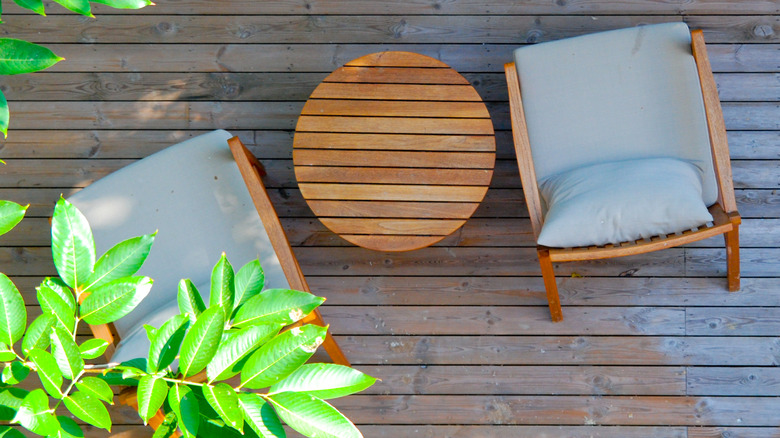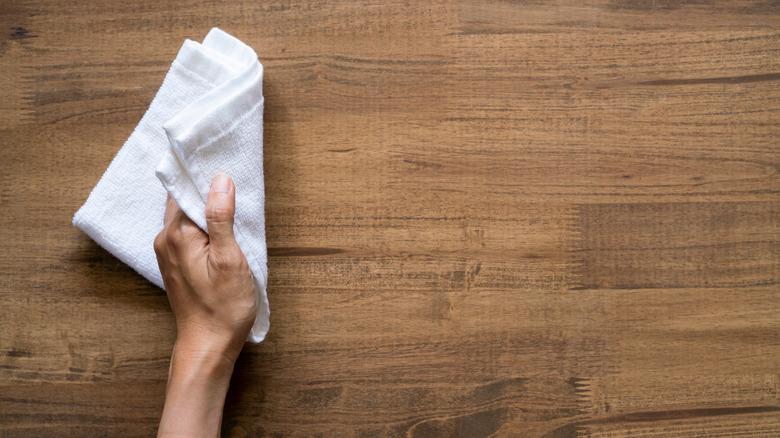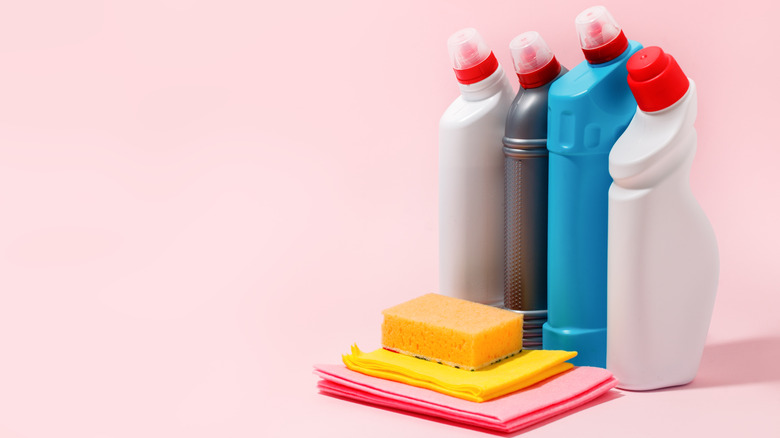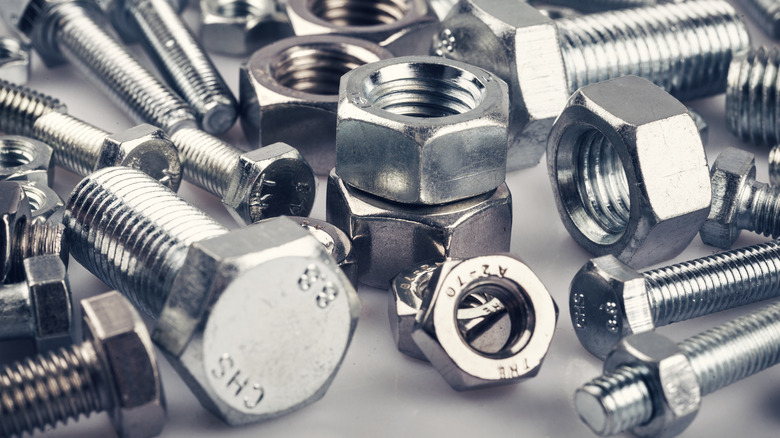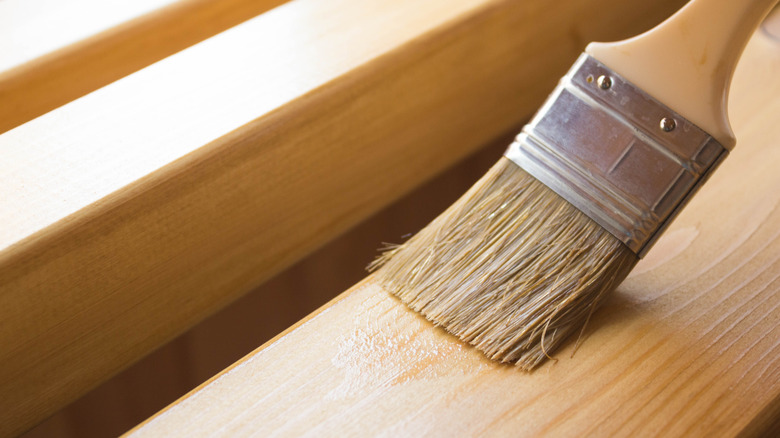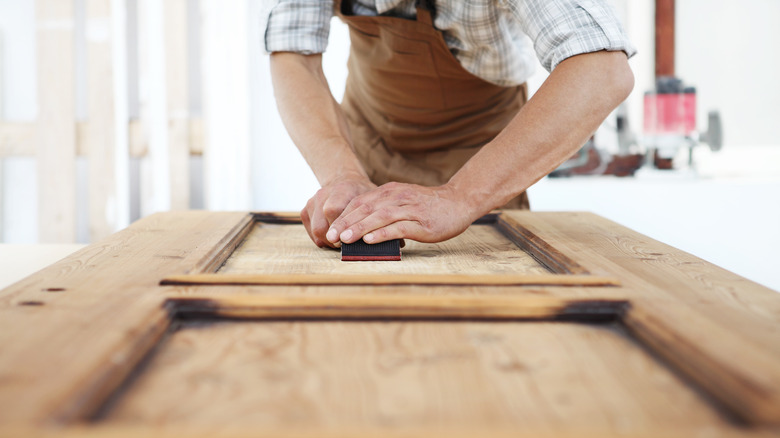How To Clean Cedar Furniture
If you use a wooden cutting board, you probably know the challenge of cleaning wood surfaces. You don't want to ruin the cutting board, but not washing it certainly isn't an option (especially if you've been slicing up fish for dinner). Like that cutting board, cleaning wood furniture can be a tricky task, and cedar specifically makes it even tricker. Just like plastic or wicker furniture, cedar furniture deserves the same attention when it comes to cleaning; however, unlike plastic or wicker, cedar calls for an entirely different cleaning process to avoid any permanent damage.
Fortunately, we've got you and your furniture covered. You don't need much to properly clean your cedar wood furniture — a little soap, a rag, and sandpaper will do. If you want to go the extra mile, you can also purchase a sealant and wood stain. According to Wood Country, these products and tools will ensure your cedar furniture lasts a very long time.
Hand wash only
If you're thinking of pressure-washing your cedar furniture to cut down on time, think again. According to Ready to DIY, extreme pressure from these washers can actually damage, and possibly ruin, cedar because it is a soft wood. The main difference between hardwood and softwood is density. Arnold Laver explains that hardwood is denser, meaning it can handle more pressure without incurring damage. Softwood is much lighter than hardwood, and significantly less dense. Be mindful of this next time your cedar furniture needs a cleaning or basic maintenance, and proceed with caution to increase the longevity of your piece.
To hand wash your cedar furniture, use a mild detergent along with a soft cleaning rag to give it a gentle but thorough clean. If you are unfamiliar with mild detergent, One Time explains that this term typically refers to dish washing soap because of its lack of builders, which are found in moderately strong detergents. Rinse with a hose on a low pressure setting to preserve the cedar.
Avoid harsh chemicals
Speaking of strong detergents, it's critical to stay away from any soaps that contain harsh chemicals such as ammonia. These are known to damage cedar if not applied correctly. For tougher stains and/or mildew that mild detergent can't remove, Forest Products Laboratory from the USDA suggests a weak solution of water mixed with oxygen bleach, as opposed to chlorine bleach. Sodium hypochlorite (the main ingredient in chlorine bleach) can be too strong and cause the wood to pulp, which will affect the surface. Again, this method should be done with caution to avoid any damage to the soft wood. Thoroughly rinse the furniture with a hose until the mixture is completely gone. Let your furniture air-dry before applying any type of sealant or wood stain.
Oxalic acid can also be used to neutralize pesky stains, but be careful because it is toxic. You can find it at most drugstores and it is a common additive to commercial wood cleaners. Only use oxalic acid outdoors or in a well-ventilated area.
Consider the metal hardware
When cleaning your cedar furniture, it's important to know how moisture affects the screws and bolts holding the furniture together. The Rust Store explains that too much moisture causes rust, which is ugly and can be quite dangerous as well. Sam's Welding, Inc. states that rusty surfaces may contain more harmful bacteria than other surfaces. If you happen to cut your self on a rusty object, it's possible to contract tetanus, which should be treated immediately. To prevent rust, make certain all bolts and screws are completely dry after cleaning your furniture.
It's crucial to regularly check and tighten the fastenings on your cedar furniture. Cedar furniture can be left outside during the winter, but this only applies to treated wood, Patio Comfort explains. If your furniture is untreated, move it to the garage or shed for seasonal storage. If you don't have the room, opt for covers instead.
No finishing oil
According to All Things Cedar, finishing oil allows dust and debris to stick to the cedar and should not be used; however, feel free to use a sealant to protect your wood furniture. Keep in mind finishing oil and sealant are not the same. Finishing oil sits on the surface, while sealant permeates through the wood's pores, says Bona. Direct exposure to sunlight can cause cedar's natural color to fade within a few months. Its once natural, pinkish-red color turns a silvery-gray instead, Hunker explains. If this occurs, there are several ways you can replenish the cedar's beautiful color.
The first method is painting your dull cedar. Cedar accepts paint, but it's important that you apply a primer before painting the wood. Another option is to apply a semi-transparent stain. Per All Things Cedar, this will maintain the natural qualities of the wood and you won't need a primer. You can even color match your stain to other pieces of furniture.
Sand by hand
Remember, cedar is soft, and therefore should be sanded by hand. According to Hunker, the only time to use an orbital sander is when your cedar is suffering from extreme damage like gouges or planer marks. Theses are lines that run against the grain of the wood. If you must use an orbital sander, make sure it's constantly moving in a circular motion. Once the wood is smooth, go back to sanding by hand.
To sand your cedar furniture by hand, first use 100-grit sandpaper to smooth away any blemishes that may have been caused by the power sander. The key to this method is to move in the direction of the wood's grain. Each short stroke should overlap the others you've already made. Work in small sections and don't rush. You'll know you're finished when the wood is sleek to the touch with no remaining notches or scratches. Whatever dust you've created can be gently wiped away.
